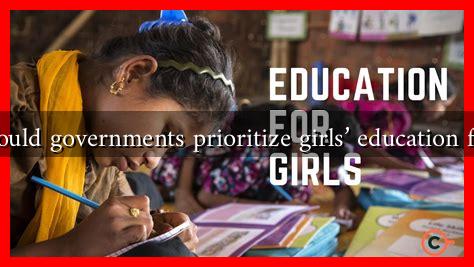-
Table of Contents
Why Should Governments Prioritize Girls’ Education Funding?
Education is a fundamental human right and a powerful tool for social and economic development. However, millions of girls around the world are still denied this right due to various barriers, including poverty, cultural norms, and lack of infrastructure. Governments must prioritize funding for girls’ education to ensure equitable access to learning opportunities. This article explores the multifaceted benefits of investing in girls’ education and presents compelling reasons for governments to take action.
The Economic Argument: Investing in the Future
Investing in girls’ education is not just a moral imperative; it is also an economic necessity. Educated women contribute significantly to economic growth and development. According to the World Bank, every additional year of schooling for girls can increase their future earnings by up to 20%. This increase in income can lead to:
- Higher family incomes, which can reduce poverty levels.
- Increased spending on health and education for future generations.
- Greater participation in the workforce, leading to a more skilled labor pool.
For instance, a study by the McKinsey Global Institute found that closing gender gaps in labor force participation could add $12 trillion to global GDP by 2025. This statistic underscores the economic potential of investing in girls’ education.
Social Benefits: Empowering Communities
Education empowers girls and women, enabling them to make informed choices about their lives. Educated women are more likely to:
- Participate in political processes and advocate for their rights.
- Delay marriage and childbirth, leading to better health outcomes for themselves and their children.
- Contribute to community development and social cohesion.
For example, in Bangladesh, the introduction of stipends for girls’ education led to a significant increase in school enrollment rates. As a result, communities witnessed improved health and economic outcomes, demonstrating the ripple effect of investing in girls’ education.
Health Outcomes: Breaking the Cycle of Poverty
Education is closely linked to health outcomes. Educated women are more likely to seek healthcare, understand health information, and make informed decisions regarding their families. Key health benefits include:
- Lower maternal and infant mortality rates.
- Increased likelihood of immunizing children.
- Better management of family health and nutrition.
A report by the United Nations Population Fund (UNFPA) indicates that if all girls completed secondary education, maternal deaths could be reduced by 70%. This statistic highlights the critical role of education in improving health outcomes and breaking the cycle of poverty.
Case Studies: Successful Initiatives
Several countries have successfully implemented programs that prioritize girls’ education, yielding positive results:
- Rwanda: Following the 1994 genocide, Rwanda made significant investments in girls’ education. The government introduced policies that eliminated school fees and provided scholarships, resulting in a dramatic increase in female enrollment rates.
- Malawi: The introduction of the “Girl’s Education Movement” has led to increased awareness and community support for girls’ education. As a result, the country has seen a rise in girls completing secondary education.
These case studies demonstrate that with the right policies and funding, significant progress can be made in promoting girls’ education.
Conclusion: A Call to Action
Prioritizing girls’ education funding is essential for fostering economic growth, empowering communities, and improving health outcomes. Governments must recognize the long-term benefits of investing in girls’ education and take decisive action to eliminate barriers to access. By doing so, they will not only uplift individual girls but also contribute to the overall development and prosperity of their nations.
In conclusion, the evidence is clear: investing in girls’ education is a smart investment for the future. It is time for governments to act decisively and prioritize funding for girls’ education, ensuring that every girl has the opportunity to learn, grow, and thrive.
For more information on the importance of girls’ education, visit UNICEF’s Girls’ Education page.

